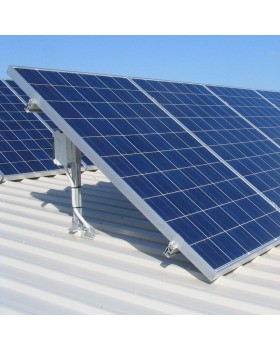Ắc quy Nickel-Cadmium (Ni-Cd ChangHong)
- Dòng sản phẩm:
- Số lượng sản phẩm trong kho: 100
Ắc quy Nickel-Cadmium, được cung cấp bởi hãng Sichuan Changhong Battery, Trung Quốc. Công ty được biết đến với tên gọi Nhà Máy Quốc Dân (National Factory) số 756, được thành lập từ năm 1971, đến nay với trên 40 năm kinh nghiệm phát triển và sản xuất ắc quy Nickel-Cadmium. Trước những năm 1980, sản phẩm ắc quy Nickel-Cadmium chỉ được cấp cho Quân đội Trung Quốc và ngành hàng không dân dụng và là một trong các nhà máy sản xuất ắc quy Nickel-Cadmium lớn nhất trên thế giới. Sau năm 1980, ắc quy Nickel-Cadmium ChangHong được xuất khẩu sang trên 50 nước trên thế giới thuộc khu vực Châu Á, Châu Âu và Bắc Mỹ.
Với lịch sử công ty như trên, các sản phẩm ắc quy của ChangHong có độ tin cậy rất cao. Tuổi thọ ắc quy dài (chúng tôi đã ghi nhận tuổi thọ của ắc quy Nickel-Cadmium đã đạt 20 năm trong rất nhiều ứng dụng khác nhau), quy trình bảo dưỡng tối thiểu, đáp ứng yêu cầu của khách hàng về ắc quy Nickel-Cadmium.
Đội ngũ kỹ trên 200 người thuộc chuyên nghành công nghệ hóa học tập trung nghiên cứu ắc quy Ni-Cd và quản lý hệ thống sản xuất đảm bảo chất lượng tốt nhất.
Ắc quy Nickel-Cadmium có chi phí đầu tư ban đầu cao hơn ắc quy Axit chì kín, tuy nhiên với những ưu điểm thực tế ắc quy Ni-Cd mang lại như độ tin cậy cao, tuổi thọ dài và khả năng xả dòng điện cho tải cao hơn, ắc quy Ni-Cd được lựa chọn nhiều trong các ứng dụng khác nhau vì chi phí - hiệu quả tối ưu.
Các chứng chỉ ChangHong đã đạt được:

Các khách hàng chính trong lĩnh vực Năng Lượng & Viễn Thông.

Cấu tạo ắc quy Ni-Cd (Loại Pocket Plate)

Ứng dụng của các loại ắc quy Ni-Cd

Hướng dẫn chọn số bình ắc quy Ni-Cd cho hệ thống một chiều 48VDC, 110VDC và 220VDC theo tiêu chuẩn IEEE11150-2004.

Ưu & nhược điểm của ắc quy Ni-Cd và ắc quy Axit chì kín.
|
|
Sealed Lead Acid |
Nickel – Cadmium battery |
|
Advantage |
- Inexpensive and simple to manufacture – in term of cost per watt hours, the SLA is the least expensive - Mature, reliable and well-understood technology when used correctly, the SLA is durable and provides dependable service - Low self-discharge – the self-discharge rate is among the lowest in rechargeable battery systems - Low maintenance requirement – no money, no electrolyte to fill. Capable of high discharge rates. |
- Fast and simple charge – even after prolonged storage - High number of charge/discharge cycles – if properly maintained, the NiCd provides over 1000 charge/discharge cycles - Good load performance – the NiCd allows recharging at low temperatures. - Long self life – in any stage-of-charge - Simple storage and transportation – most airfreight companies accept the NiCd without special conditions - Good low temperature performance - Forgiving if priced – the NiCd is one of the most rugged rechargeable batteries - Economically price – the NiCd is the lowest cost battery in terms of cost per cycle - Available in a wide range of sizes and performance options. |
|
Disadvantage |
- Cannot be stored in discharge condition - Low energy density – poor weight-to-energy density limits use to stationary and wheeled applications - Allows only a limited number of full discharge cycles – well suited for standby applications that require only occasional deep discharges - Environmentally unfriendly – the electrolyte and the lead content can cause environmental damage - Transportation restrictions on flooded lead acid – there are environmental concerns regarding spillage in case of an accident - Thermal runaway can occur with improper charging - The SLA has a relative low energy density compared with other rechargeable batteries, making it unsuitable for handled devices that demand compact size. In addition, performance at low temperatures is greatly reduced - The SLA is rated at a 5-hour discharge or 0.2C. Some batteries are even rated at a slow 20 hour discharge. Longer discharge times produce higher capacity readings. The SLA performs well on high pulse currents. During these pulses, discharge rates well in excess of 1C can be drawn. - In term of disposal, the SLA is less harmful than the NiCd batteries but the high lead content makes the SLA environmentally unfriendly. Ninety percent of lead acid-bases batteries are being recycled. |
- Relative low energy density – compared with newer systems. - Memory effect – the NiCd must periodically be exercised to prevent memory. - Environmentally unfriendly – the NiCd contain toxic metal - Some countries are limiting the use of the NiCd battery - Has relatively high self-discharge – needs recharging after storage. |
Link download tài liệu








